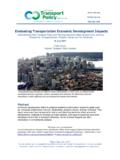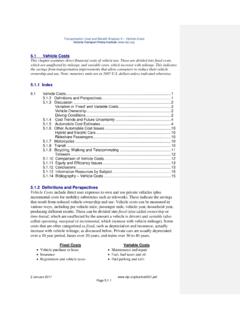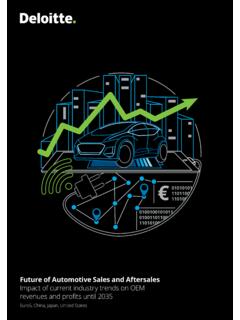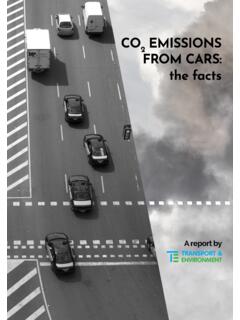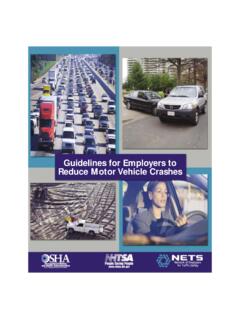Transcription of Autonomous Vehicle Implementation Predictions
1 Phone 250-508-5150 Todd Alexander Litman 2013-2022 You are welcome and encouraged to copy, distribute, share and excerpt this document and its ideas, provided the author is given attribution. Please send your corrections, comments and suggestions for improvement. Autonomous Vehicle Implementation Predictions Implications for Transport Planning 3 March 2022 By Todd Litman Victoria Transport Policy Institute Waymo s self-driving taxis are a well-publicized example of Autonomous vehicles. Summary This report explores the impacts of Autonomous (also called self-driving, driverless or robotic) vehicles, and their implications for transportation planning. It investigates how quickly such vehicles are likely to develop and be deployed based on experience with previous Vehicle technologies; their likely benefits and costs; how they will affect travel activity; and their impacts on road, parking and public transit planning.
2 This analysis indicates that Level 5 Autonomous vehicles, able to operate without a driver, may be commercially available and legal to use in some jurisdictions by the late 2020s, but will initially have high costs and limited performance. Some benefits, such as independent mobility for affluent non-drivers, may begin in the 2030s but most impacts, including reduced traffic and parking congestion, independent mobility for low-income people (and therefore reduced need for public transit), increased safety, energy conservation and pollution reductions, will only be significant when Autonomous vehicles become common and affordable, probably in the 2040s to 2060s, and some benefits may require dedicated Autonomous Vehicle lanes, which raises social equity concerns. Autonomous Vehicle Implementation Predictions : Implications for Transport Planning Victoria Transport Policy Institute 2 Table of Contents Executive Summary.
3 3 Introduction .. 7 Autonomous Vehicle Operational Models .. 8 Benefits and Costs .. 9 Reduced Driver Stress, Improved Productivity and Mobility .. 9 Ownership and Operating Costs .. 10 Traffic Safety and Security .. 13 External Cost .. 15 Social Equity Impacts .. 16 Benefit and Cost Summary .. 18 Travel Impacts .. 20 Development and Deployment Predictions .. 25 Experience with Previous Vehicle Technology Deployment .. 28 Deployment Predictions .. 29 Planning Implications .. 32 Roadway 32 Transportation Pricing .. 32 Curb Management .. 32 Parking Planning .. 32 Public Transit Needs .. 33 Other Trends Affecting Travel Demands .. 33 Potential Conflicts and Solutions .. 37 Conclusions .. 38 References .. 41 Driving in mixed traffic involves numerous interactions with diverse pedestrians, animals, bicyclists and vehicles, and so is more complex than flying an airplane. (Keith Shaw) Autonomous Vehicle Implementation Predictions : Implications for Transport Planning Victoria Transport Policy Institute 3 Executive Summary Many decision-makers and practitioners wonder how Autonomous (also called self-driving or robotic) vehicles (AVs) will affect future travel, and therefore the need for roads, parking facilities and public transit services, and what public policies can minimize the problems and maximize the benefits of these new technologies.
4 This report explores these issues. Optimists predict that by 2030, Autonomous vehicles will be sufficiently reliable, affordable and common to displace most human driving, providing huge savings and benefits. However, there are good reasons to be skeptical. Most optimistic Predictions are made by people with financial interests in the industry, based on experience with disruptive technologies such as digital cameras, smart phones and personal computers. They tend to ignore significant obstacles to Autonomous Vehicle development, and exaggerate future benefits. There is considerable uncertainty concerning Autonomous Vehicle development, benefits and costs, travel impacts, and consumer demand. Considerable progress is needed before Autonomous vehicles can operate reliably in mixed urban traffic, heavy rain and snow, unpaved and unmapped roads, and where wireless access is unreliable. Years of testing and regulatory approval will be required before they are commercially available in most jurisdictions.
5 The first commercially available Autonomous vehicles are likely to be expensive and limited in performance. They will introduce new costs and risks. These constraints will limit sales. Many motorists will be reluctant to pay thousands of extra dollars for vehicles that will sometimes be unable to reach a destination due to inclement weather or unmapped roads. Exhibit ES-1 illustrates Autonomous Vehicle user costs. They are likely to be more expensive than human-driven private vehicles and public transit, but cheaper than ridehailing and human-driven taxis. Shared Autonomous vehicles will be cheaper but less convenient and comfortable than private AVs, so many households, particularly in suburbs and rural areas, will own AVs. Exhibit ES-1 Cost Comparison Autonomous vehicles (AVs) are likely to cost more than human-operated (HO) private vehicles and public transit, but less than human-driven taxis and ridehailing services.
6 $ $ $ $ $ $ carvariablecostsShared AVPublictransitAV variablecostsHD caraveragecostsAVTaxiAVaveragecostsRide- hailingHOTaxiDollars Per Mile Autonomous Vehicles (AV)Human Driven (HD) Autonomous Vehicle Implementation Predictions : Implications for Transport Planning Victoria Transport Policy Institute 4 Autonomous vehicles will have various benefits and costs, including many external costs (costs imposed on other people). All of these impacts should be considered when planning for AVs. Exhibit ES-2 Autonomous Vehicle Potential Benefits and Costs Benefits Costs/Problems Internal (user Impacts) Reduced drivers stress and increased productivity. Motorists can rest, play and work while travelling. Mobility for non-drivers. More independent mobility for non-drivers can reduce motorists chauffeuring burdens and transit subsidy needs. Reduced paid driver costs. Reduces costs for taxis services and commercial transport drivers.
7 Increased Vehicle costs. Requires additional Vehicle equipment, services and fees. Additional user risks. Additional crashes caused by system failures, platooning, higher traffic speeds, additional risk-taking, and increased total Vehicle travel. Reduced security and privacy. May be vulnerable to information abuse (hacking), and features such as location tracking and data sharing may reduce privacy. External (Impacts on others) Increased safety. May reduce crash risks and insurance costs. May reduce high-risk driving. Increased road capacity and cost savings. More efficient Vehicle traffic may reduce congestion and roadway costs. Reduced parking costs. Reduces demand for parking at destinations. Reduced energy consumption and pollution. May increase fuel efficiency and reduce emissions. Supports Vehicle sharing. Could facilitate carsharing and ridesharing, reducing total Vehicle ownership and travel, and associated costs.
8 Increased infrastructure costs. May require higher roadway design and maintenance standards. Additional risks. May increase risks to other road users and may be used for criminal activities. Increased traffic problems. Increased Vehicle travel may increase congestion, pollution and sprawl-related costs. Social equity concerns. May reduce affordable mobility options including walking, bicycling and transit services. Reduced employment. Jobs for drivers may decline. Reduced support for other solutions. Optimistic Predictions of Autonomous driving may discourage other transport improvements and management strategies. Autonomous vehicles can provide various benefits and costs, including external impacts on other people. Vehicles last longer, cost more, impose larger external costs, and are more highly regulated than most other consumer goods. As a result, Vehicle technologies take longer to penetrate markets than most other sectors.
9 It will probably take decades for Autonomous vehicles to dominate new Vehicle purchases and fleets, and some motorists may resist using them. Optimistically, Autonomous vehicles will be safe and reliable by 2025, and may be commercially available in many areas by 2030. If they follow the pattern of previous Vehicle technologies, during the 2030s and probably the 2040s, they will be expensive and limited in performance, sometimes unable to reach a desired destination or requiring human intervention when they encounter unexpected situations. Customers will include affluent high-annual-mileage motorists and businesses. For the foreseeable future most moderate- and low-income households will continue to use human-operated vehicles. Autonomous Vehicle Implementation Predictions : Implications for Transport Planning Victoria Transport Policy Institute 5 Shared Autonomous vehicles (self-driving taxis) and rides (micro-transit services) may be widely available by the 2030s.
10 Shared vehicles have moderate operating costs, and offer moderate convenience and comfort. They should be cheaper than current taxi and ridehailing services, but offer lower quality service since no driver will be available to assist passengers, provide security, or clean vehicles. Vehicle dispatching will sometimes be slow and unpredictable, particularly in suburban and rural areas. Shared rides will have the lowest costs but the least convenience and comfort. Because of their high labor costs and predictable routes, long-haul buses and freight trucks are particularly appropriate for Autonomous operation, so self-driving buses and trucks may become common in the 2030s and 2040s. The figure below illustrates these market penetration and benefits projections. This indicates that it will probably be 2045 before half of new vehicles are Autonomous , 2060 before half of the Vehicle fleet is Autonomous , and possibly longer due to technical challenges or consumer preferences.
